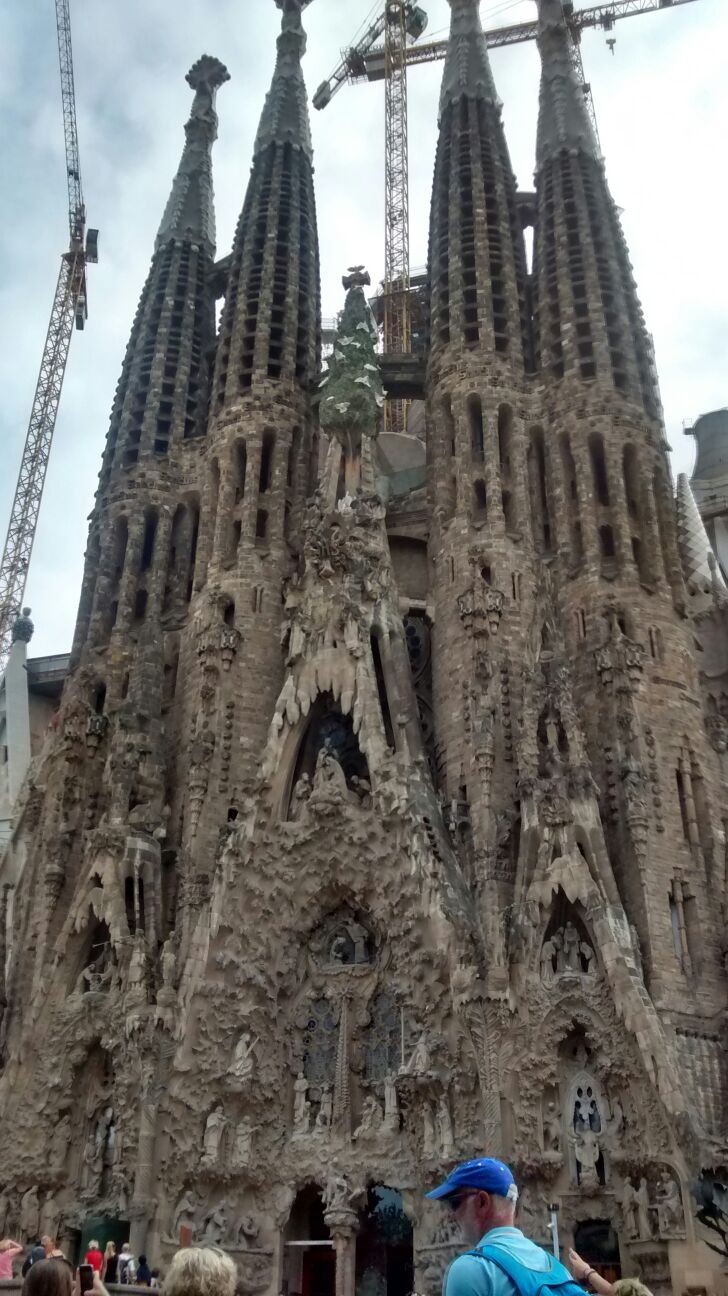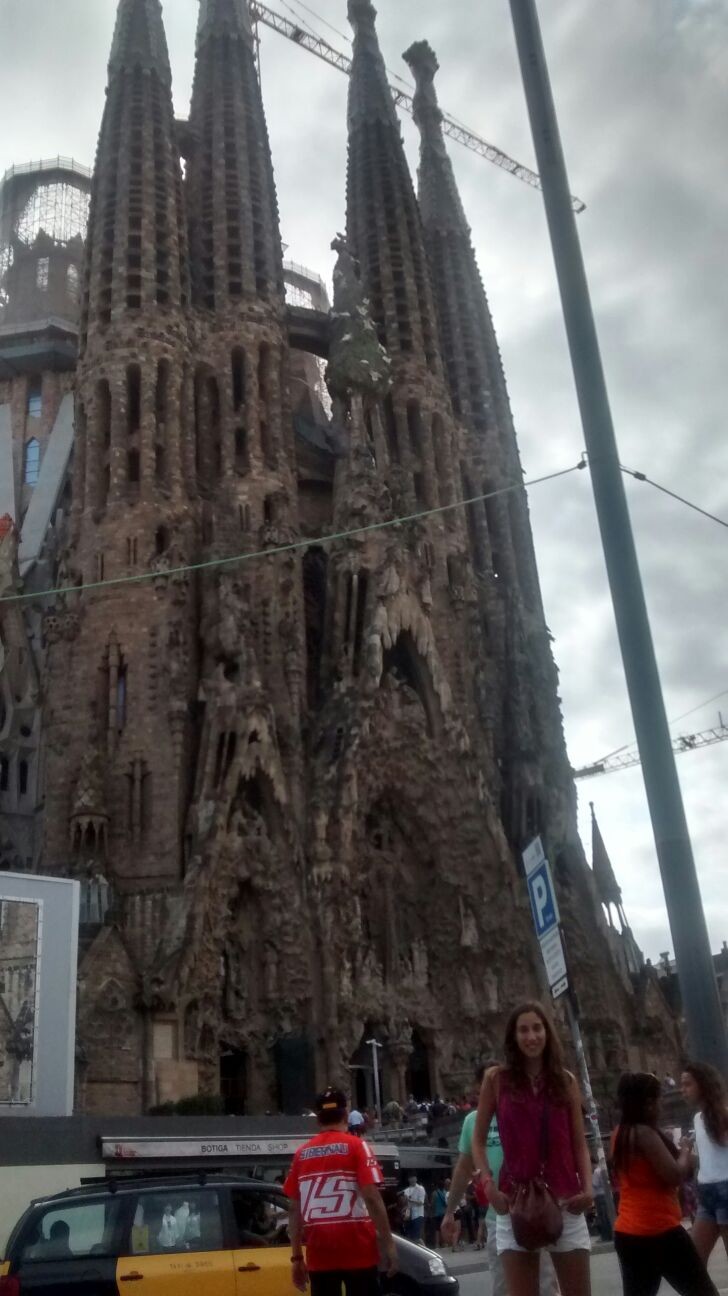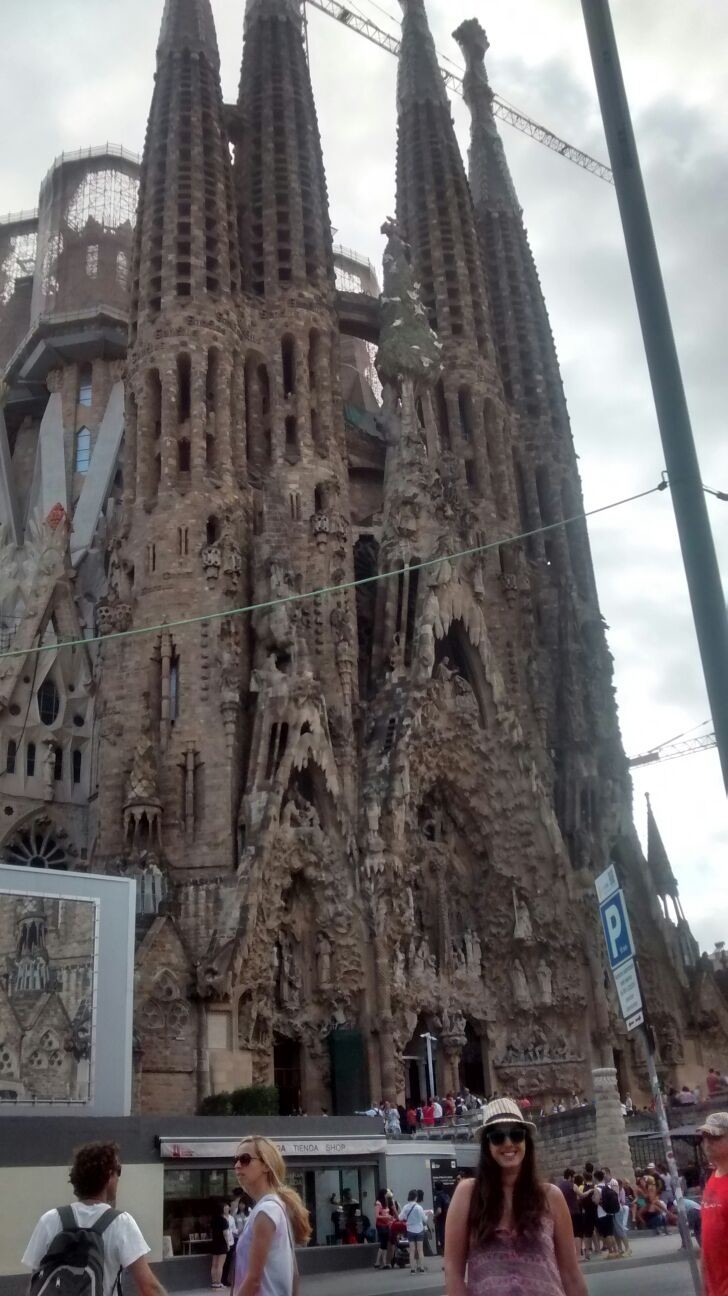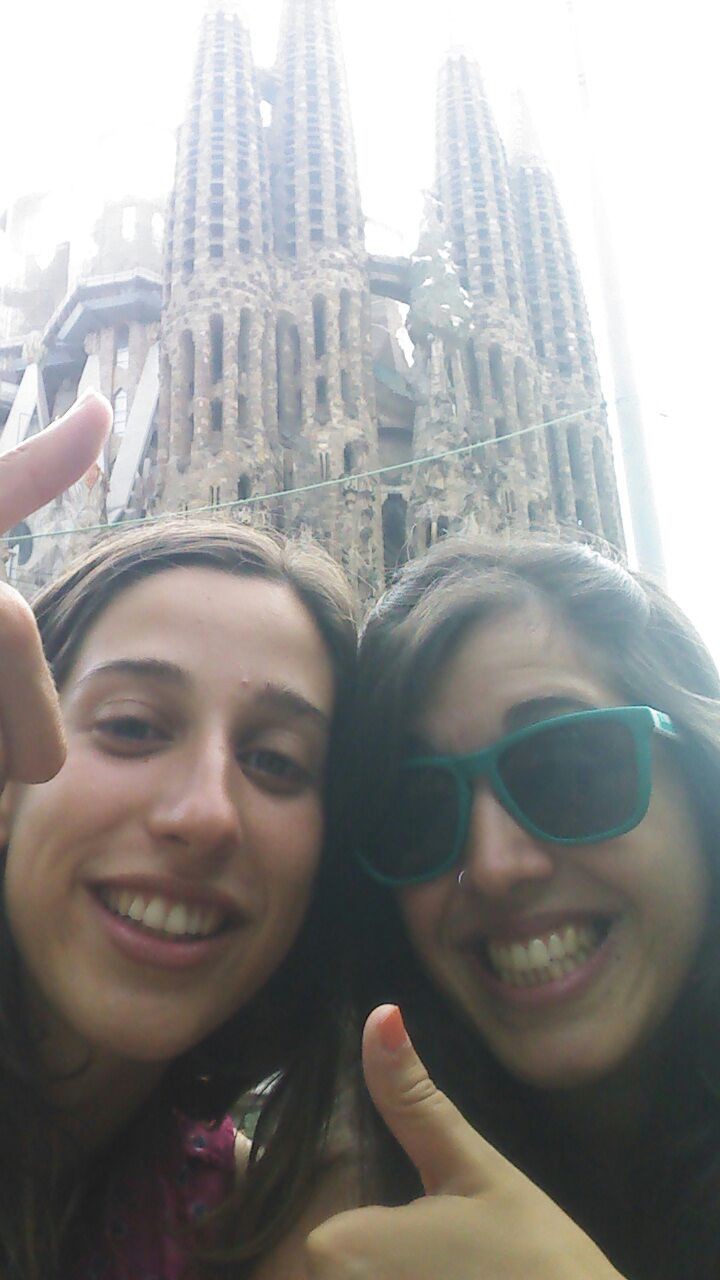Sagrada Familia Basilica
- Address: Barcelona
- Tags:
 What to see Barcelona,
Barcelona,
Spain
What to see Barcelona,
Barcelona,
Spain
- Website: http://www.sagradafamilia.cat/
The Sagrada Familia, an unfinished masterpiece
Among the most recent places I've visited is the one and only Barcelona. A very in-demand tourist destination, Barcelona is not only popular on a national but also on a worldwide level. The Catalan city has the second highest population in Spain (after Madrid), with more than 1. 5 million inhabitants.
Some articles and even the Barcelona natives themselves say that the city is flooded with thousands of tourists, not just in the summertime but all year round - and they're right. From the fantastic monuments, to the beaches and the city's captivating atmosphere, Barcelona has it all.
In this first entry about my trip to Barcelona, I'll be telling you about our fantastic visit to the Sagrada Familia basilica, one of the most emblematic monuments in the city. I'll add some interesting facts which are, in my opinion, essential for everyone who wants to visit it. Without exhausting you with lots of dates and history, I do think that every tourist should educate themselves about places they're going to visit, and that by doing this they'll enjoy themselves much more.

The Sagrada Familia Basilica
Every visitor to Barcelona should see the Sagrada Familia, undoubtedly a symbol of the Catalan city. Personally, I'm not really a fan of visiting the inside of cathedrals or churches unless I've got an architect or an engineer with me who can explain the ins and outs of its construction, its paintings and decorations and the history of the building... However, the Sagrada Familia is a work of art in itself, and even a person who knew nothing about architecture would find it impressive. It's an unexplainable wonder, something you can only understand when you see it for yourself. It's totally different to the other churches and cathedrals you can visit in Europe, and your visit is much more interesting if you learn about the history of the place and its architecture.
On most days, you can also climb the towers, from the top of which you can see the whole of Barcelona. You can buy tickets to climb the towers when you first enter the cathedral (specific prices are listed below under the subheading 'Tickets'). The tower ticket pushes up the entrance price a little, but it's definitely worth it. Sadly, we didn't go up the towers and so I can't tell you from my own experience how fantastic it was, but I think if you ask anyone who has done it, they'll tell you that it's an unmissable opportunity.
Barcelona is, of course, a city full of charm and the location of some of the most emblematic and well-known monuments and places in our country. Tourists should allow a lot of time for their visit to the Sagrada Familia, since just getting in can be quite a challenge. The best thing to do is to get up really early and get in the queue as soon as you can, since otherwise you could spend ages waiting to be let in - the queue seems never-ending. While we spent an hour queuing like the naive tourists that we were, one of the people we got talking to waiting in the queue with us (an expert on the basilica, at least compared to us) told us that the Sagrada Familia is the most visited monument in the whole of Spain, even in comparison with other well-known ones such as the Alhambra Palace in Granada, and the Museo del Prado in Madrid. We looked online at how many people visit the Sagrada Familia annually, and the figure was an astounding 3. 2 million! After reading this number, the hour-long queues surrounding the beautiful basilica almost seem short.
On your visit, make sure to walk all the way around the outside of the basilica. Some tourists make the mistake of just sticking by the facade from the postcards and TV adverts, and don't get to see the other sides of the building. Apart from the undoubtedly most famous side, there are three others which are all very impressive (despite the nets and scaffolding): the Nativity Facade, the Passion Facade and the Glory Facade.
The Nativity Facade
This facade is dedicated to the birth of Jesus, and is very ornate. It is known by other names such as the Life, Joy or Christmas Facade. It features three porticos: hope, charity and faith (left to right), separated by robust columns which represent Mary and Joseph.
The Passion Facade
This facade is dedicated to the passion of Jesus, reflecting the suffering he underwent at the Crucifixion. This side is intended to be more austere, simpler and less ornamental since it aims to resemble Jesus' skeleton. West-facing, this facade receives the final sunlight of the day until the sun sets, accentuating the symbolism of darkness.
The Glory Facade
This facade represents the heavenly glory of Jesus. At present, it's more like a rough draft, as it still isn't finished. The Glory Facade is the main facade, intended to be the biggest and most impressive one of all three. South-facing, sunlight should illuminate it for the majority of the day, giving it a deeper significance in terms of Jesus' ascension to heaven.
Museum
The Sagrada Familia Cathedral also features a museum in its basement, opened in 1961, though I haven't visited it myself. It's here that the original plans and sketches of the Catalan architect Antoni Gaudí are kept, as are photographs of his other architectural works and biographical texts of his... there's also an audiovisual room.

History
Despite work on the basilica beginning in 1882, the cathedral remains incomplete today in 2014, making the place all the more interesting. Visitors will see the scaffolding and construction works which surround the basilica, though the work has stopped for the moment.
Construction began in 1882 in a Neo-Gothic style. However, Antoni Gaudí redirected the project the following year at only 31 years of age, placing emphasis on contemporary Catalan Modernist features which make the building so important today and devoting the rest of his life to the project.
When Antoni Gaudí was placed in charge of the building the basilica, he knew it would be no easy job, and neither would it be a quick one, instead lasting several centuries and that he himself wouldn't live to see it finished. Because of this, he decided to construct one the facades first so that it might serve as inspiration to the next generations charged with finishing this work of art.
An unfinished masterpiece
Though it is commonly known as the 'Sagrada Familia', its complete name is the Expiatory Church of the Holy Family, a Catholic basilica. As many people know, it was designed by the well-known architect Antoni Gaudí, who left as his legacy this incomplete masterpiece, a fabulous example of Catalan Modernist architecture of which its creator was a patron. On the death of the architect in 1926, the Sagrada Familia was left incomplete, and only one of the planned eighteen towers had been erected: twelve dedicated to the apostles, four to the evangelists and the last two to Mary and Jesus. Work on the basilica is still ongoing (though very slow), since plans exist which show the intentions of Antoni Gaudí, including a plaster model which was damaged in the Civil War. As of today, eight of the eighteen towers have been erected. 2024 is the current proposed finish date for the basilica. Some Catalans told us that incertainty about the finish date and the sluggishness of progress is due in part to lack of funding, since the basilica has been entirely built on donations right from the very beginning. It now also receives the money earned from visitors (which must be loads! ).
In addition to being a cultural symbol of Barcelona, in 2005 the Sagrada Familia was made a UNESCO World Heritage Site. It was also suggested as one of the seven wonders of the modern world.

Location
The towers of the huge basilica can be seen from many parts of the city. It is located in the district of the same name: Sagrada Familia District, and its full address is 'Carrer de Mallorca, 401'.
How to get there
Use the metro or the train to get to the Sagrada Familia. The nearest metro stop is also called 'Sagrada Familia', and is on line 2. If you prefer travelling by bus, you can use lines 19, 33, 34, 43 and 44 to get there (if I'm not mistaken).
Opening hours
The opening hours of the Expiatory Church of the Holy Family depend on the season during which you visit:
- From October to March, the basilica is open Monday to Sunday from 9am to 6pm.
- From April to September, the basilica is open Monday to Sunday from 9am to 8pm.
- Exceptions: on the 1st and 6th January, as well as on the 25th and 26th December the basilica is only open from 9am to 2pm.
Tickets
Tickets can be bought at the ticket office at the Sagrada Familia. However, most people recommend buying them online beforehand, as limited discounts are available and you can avoid the huge queues.
Prices
- General Ticket: 14. 80€
- Reduced Ticket: 12. 80€
- Entrance to the Basilica plus Guided Tour: 19. 30€
- Entrance to the Basilica plus Audioguide: 19. 30€
- Entrance to the Basilica plus Tower Access: 19. 30€
- Entrance to the Basilica plus Audioguide and Tower Access: 23. 80€
http://www.sagradafamilia.cat/sf-cast/docs_serveis/infoTarifesInd.php - On this website, you can view more details on the price of each option and what each includes, and also take a look at the discounts available.
For more information, visit the main website of the Sagrada Familia, too: http://www.sagradafamilia.cat/ This website contains almost all the information you could possible need. You can take a look at the permanent exhibitions on display in the museum, as well as the temporary ones, and see what will be on at the time of your visit.
If for any reason you're unable to visit the inside of the monument, there is a virtual tour online of the inside and different facades: http://www.sagradafamilia.cat/docs_instit/vvirtual.php?vv=1

I hope this article has been useful to you, has answered some of your questions and provided you with basic information to help with your visit to this fabulous monument of Gaudí's. Bye for now, and don't hesitate to ask me any questions about my personal experience - you know how to get hold of me!
Photo gallery
Content available in other languages
- Español: Sagrada Familia, obra maestra inacabada
- Français: La Sagrada Familia, une oeuvre inachevée
- Polski: Sagrada Familia, dzieło niedokończone
- Italiano: Sagrada Familia, un capolavoro incompiuto
The Eighth Wonder of The World
The Great Wall of China, the ancient city of Petra: Jordan, the statue of Christ the Redeemer: Brazil, the Great Pyramid of Giza: Egypt, the remains of Machu Picchu: Peru and those of Chichen Itza: Mexico, Rome's ancient Colosseum, and India's Taj Mahal. Do you know what all these places have in common? Obviously! They're the 7 wonders of the world! Now, if we had to add another monument to the list, my vote would go to (without a shadow of a doubt), La Sagrada Familia, Barcelona.
I know most of you are probably rolling on the floor with laughter at this point. I get it. But until you've seen La Sagrada Familia for yourself you'll never understand its majesty. Even for those of you who have seen it, it's not easy to fully appreciate the profound meaning that it holds. Now, I'm not claiming to have superior knowledge or greater understanding over anyone else, what I am stating however, is that this is a spiritual matter. La Sagrada Familia isn't just an enormous church, or an incredible work of art, nor is it an extraordinary (undefinable) piece of architecture. It's a temple, whose fundamental purpose was to unify man with God, at least this was the creator's intention. As a believer myself, I'm fortunate enough to be familiar with establishing such a connection. And even if you don't believe, it's near enough impossible not to moved by La Sagrada Familia or to feel at least some sense of spiritual awareness. Unless of course you're one of those people who's constantly on their phone, the entire time!
Regardless, I'm fully aware that what I've said up til might not have been completely useful for those wishing to visit this wonderful site, so I'll try my best to leave my personal opinions to an aside for now. First off, let me just say that La Sagrada Familia is the number 1 place to visit in Barcelona. It doesn't matter if you're running short on site seeing time, you cannot leave Barcelona without having seen this unique monument. It's easy to get to, all you have to do is hop on the underground and get either the L2 or L5 line. It's wise to buy your tickets in advance (best way to do so is online), that way you won't have to queue for an entirety at the station; if you can, you could even try getting there early in the morning: that way you'll avoid the wave of large tourist crowds.
Even though you can enjoy La Sagrada Familia outside for free, I have to say that it's really only a breakthrough solution (as you won't get to appreciate its immense charm), for those of you who are running on a strict schedule. After all, buying a ticket isn't going to cost you an arm and a leg: with entry tickets at 15 euros each, and for 20 euros you'll be granted access to view the building's towers, it's not that bad of a deal. Plus with just an extra 3 euros more you can have you own audio guide (which I strongly recommend to get), and naturally there are always discounts for: students, children, and those with disabilities.
If the ticket price still seems costly, it's actually considerably lower compared to the other tourist attractions in Barcelona, such as: Camp Nou or Casa Batllò. Additionally, the cost of the ticket is completely understandable (at least from my pointy of view), as it contributes towards the necessary funds for La Sagrada Familia.
Yes, you might find yourselves questioning, "how can it be possible for a building which began construction in 1886 to be still under construction? ", Well, let's say that its incompleteness is, at least for the time being, one of its most distinctive of features (if not the main). I say this out of two reasons: 1) the project was incredibly ambitious, which near enough challenged the limitations of human possibilities and 2) the series of torment events that the church (and the city of Barcelona) encountered during the last century, (but none of this stopped Gaudi). The history of this iconic building is so extraordinary that it deserves a brief summery: In 1883 Antoni Gaudi replaced another local architect who, at the time, was entrusted to design a new church which could accommodate 13, 000 people.
However, when Gaudi took over the project became so ambitious that the funds for building began to fall short, and when there weren't any funds left, now obsessed with his project, Gaudi did everything in his power to find the necessary funds. In 1926, after having spoken to potential investors and having spent all of his own money on the project, the architect sadly passed away, completing only the crypt, part of the apse, and one of the four facades. To make things even worse, when the Civil War broke out in 1936, the anarchists destroyed the interior of La Sagrada Familia. It was only in 1952 that architects could resume with the construction works, relying on digital restorations of whatever material they'd found from Gaudi's plans. Yet, this sparked a controversy, some argued that the new plans were not in line with the ideas and style of the original creator. Yet construction continued as normal, and in 1976 the building was reborn, complete with sculptural decorations created by Catalan artist, Josep Maria Subirachs, which were added decades later. This caused more uproar, but the works continued, and in 2010 the roof was finally complete, allowing Pope Benedict XVI to consecrate the basilica with a solemn celebration.
As my summary demonstrates, La Sagrada Familia is certainly not just a simple tourist site, but rather an extraordinary monument whose history has not yet been fully written. Nevertheless, the building in its present state, really does deserve a more accurate examination. The Nativity Scence, one of the four original plans to have been (almost) completed by Gaudi. Was built on a distinctive type of brown stone, which displays a variety of incredible features. The piece is divided into three parts, which Gaudi intentionally crafted, to represent the three theological virtues: Hope, Charity and Faith. The main scene is, of course, The Nativity, but other secondary cadres are dedicated to the: Annunciation, the Escape from Egypt, the Bloodshed of Innocents, and Jesus in the Temple.
Each biblical figure is sculpted in great detail, an interesting fact which helped achieve this was Gaudi's unique artist approach. Using a plaster cast of the faces of various people, Gaudi incorporated the facial features of each cast to characterise his biblical figures (from the Shepard's to the Three Wise Men); resulting in an astonishing finish. Additionally, the abundance of animals and plants found in this piece are a representation of the typical flora and fauna found in Catalonia, portraying the important contribution of each element surrounding the birth of Christ. This is similarly seen in another piece, the so-called Tree of Life, whose lively green colour was intentionally chosen so it could stand out in sharp contrast from the brown stone it was designed on.
Content available in other languages
- English: L'ottava meraviglia del mondo (1)
- Español: La octava maravilla del mundo (1)
Rate and comment about this place!
Do you know Sagrada Familia Basilica? Share your opinion about this place.


















